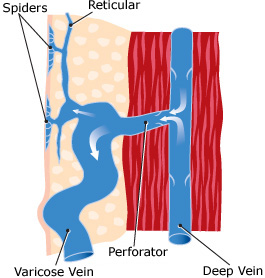
What is a telangiectasia? What is a spider vein?
A telangiectasia is a confluence of dilated intradermal venules of less than 1 mm in size. Telangiectasias are more commonly known as spider veins and thread veins. They can be pink, red and have different hues in the red to purple blue range. Spider veins occur in 15 % of men and 25 % of women in the general population.In the classification of veins, telangiectasias are classified as type I veins. We use the Palomar Laser system as well as traditional and foam sclerotherapy techniques to treat spider veins at the Vein Treatment Center.
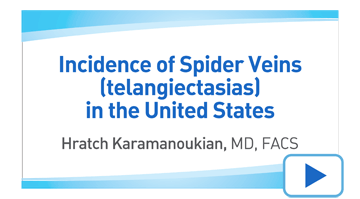
Watch the video below of Dr Raffy Karamanoukian on The Doctors TV Show with foam sclerotherapy for spider and reticular veins.
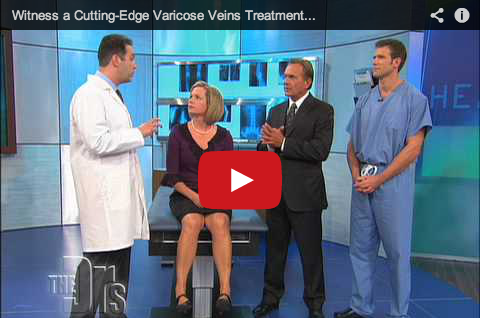
What is a reticular vein?
A reticular vein is a dilated bluish intradermal vein, usually from 1 mm in diameter to less than 3 mm in diameter. They are usually tortuous. Reticular veins are also known as blue veins and intradermal varices. In the classification of veins, reticular veins are considered type III veins. Telangiectasias (type I veins) can result from refluxing reticular veins. When such reticular veins are associated with telangiectasias, they are called "feeder veins". If sclerotherapy is chosen as the treatment for a particuar patient, the reticular veins should be injected first and the telangiectasias last. Until the reticular veins are treatd first, telangiectasias should not be targeted so as to avoid early recurrence. We utilize dynamic foam sclerotherapy and ultrasound guided foa sclerotherapy to treat reticular veins at the Vein Treatment Center.
What causes spider veins?
The causes of varicose veins are varied and are related to reflux disease at the saphenofemoral juntion (venous reflux disease) or perforators at the thigh, knee or ankle. Venous reflux disease causing varicose veins can be treated using vein stripping orradiofrequency closure.
However, the etiology contributing to the development of spider veins are multiple and include heredity, pregnancy, hormonal factors, weight gain and occupations that necessitate prolonged sitting or standing.
Spider veins are less than 1 mm in diameter. Reticular veins are 1 mm to 3 mm in diameter.
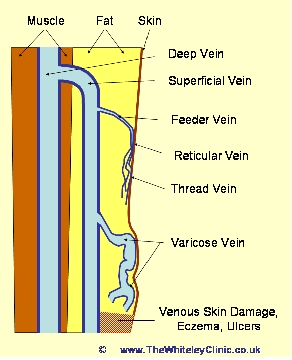
The image above shows how varicose veins, reticular veins and spider veins originate from the superficial venous system of veins - in this cartoon the great saphenous or short saphenous veins. Image taken from www.TheWhiteleyClinic.co.uk on January 15, 2009.
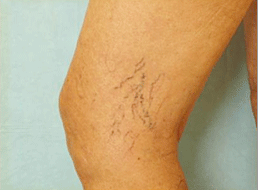
How can spider veins be treated?
Spider veins are treated by foam sclerotherapy. This is an office based procedure where veins are injected with micro puncture technology using specialized lighting to amplify spider veins and reticular veins that "feed" the spider veins.
The sclerotherapy solution causes the spider veins to collapse and fade.
For a video of sclerotherapy performed by Dr. Karamanoukian click on the video below:
LASERS are also used to treat spider veins. LASER stands for light amplification by the stimulated emission of radiation. Intense pulse light (IPL) has also been used to treat spider veins and telangiectasias. We employ all of these techniques at the Vein Treatment Center, namely sclerotherapy, lasers and IPL depending on the type of spider vein or reticular vein being treated.
Several lasers are available at the Vein Treatment Center for specific purposes and utilize different wavelengths for treatment of spider and reticular veins - the wavelengths of these lasers range in the 514 nm range (Argon laser) to the Nd:YAG laser which operates at 1064 nm. Each wavelength uses a specific fluence to cause vessel destruction. The expertise is delivered by a cardiothoracic surgeon (Dr. Hratch Karamanoukian) and a plastic surgeon (Dr. Raffy Karamanoukian). Their collective expertise in laser technology brings only the best care to patients being treated at the Vein Treatment center - improved symptoms and optimal cosmetic effect. We have acheived a very high level of patient satisfaction (> 99%) for the treamtent of spider and reticular veins at the Vein Treatment Center.
Lasers have theoretical advantages compared with traditional sclerotherapy using saline for treating spider and reticular veins. Sclerotherapy induced hyperpigmentation is caused by hemosiderin deposition and an inflammatory response. Hemosiderin deposition occurs through extravasated red blood cells . Laser coagulative destruction of spider veins does not have this response.
At the Vein Treatment Center, we utilize our expertise in using laser devices to achieve the response sought by most patients. Patients seek treatment for spider veins mostly for cosmetic reasons. We use our keen understanding of the appropriate laser and IPL device so that the treatment is targeted to the specific vessel being ablated.
However, the latest and best sclerotherapy technique using foam is an excellent technique for the vast majority of patients with spider veins, reticular veins and small varicose veins.
No matter which technique is used, it is important to treat the underlying cause such as venous reflux disease originating at the groin (saphenofemoral venous reflux), behind the knee (saphenopopliteal venous reflux) or along perforator veins (perforator venous reflux) before laser or IPL or sclerotherapy is attempted. This reduces recurrence and optimizes the efficacy and success of treatment.
We are the only center in Western New York that has EVLA technology and VNUS Closure technology under one roof. We have extensive experience with both of these technologies in the comfort of our state of the art facilities. All of our procedures are done using local anesthesia and patients depart the office within 40 minutes of their arrival in most cases
For information regarding sclerotherapy, laser ablation of spider and reticular veins or the VNUS Closure and EVLA procedures, contact Dr. Karamanoukian at 716-839-3638.
The Vein Treatment Center is a National Center of Excellence for Vein Disorders. Dr. Karamanoukian is listed in the 'Guide to America's Top Surgeons' by the Consumers Research Council of America. VeinsVeinsVeins.com is a highly rated and objective portal for information about VNUS Closure, EVLA, varicose veins, spider veins and reticular veins.